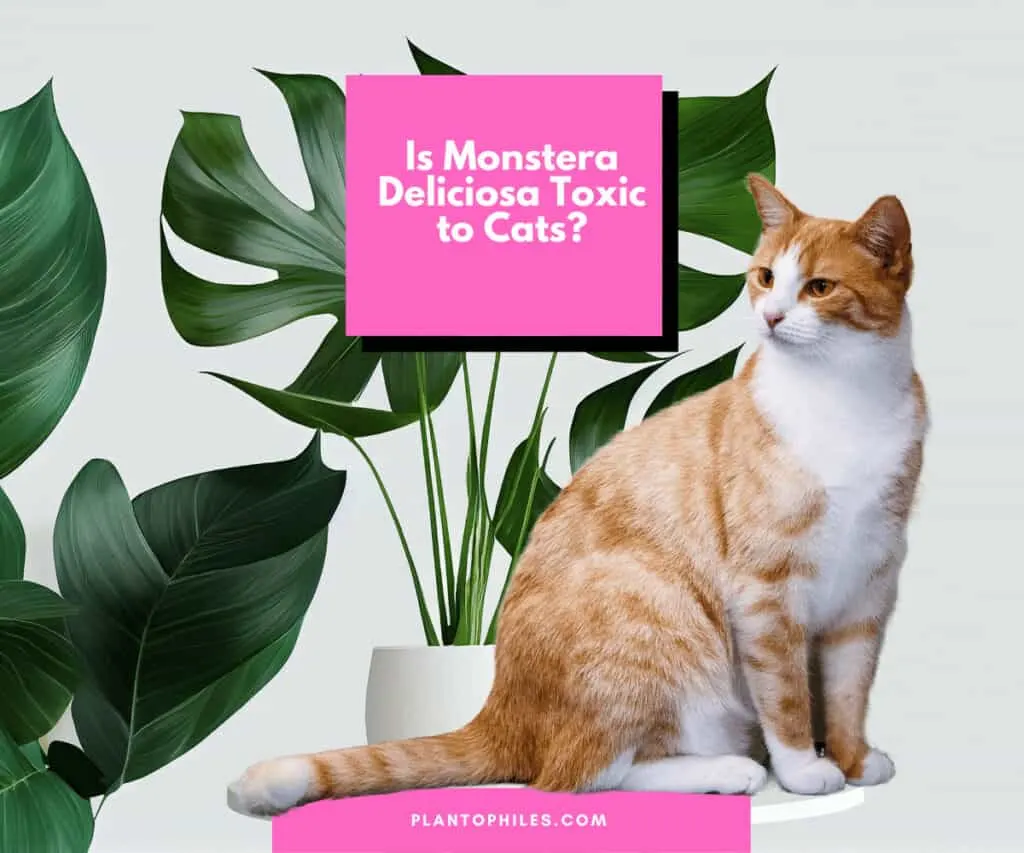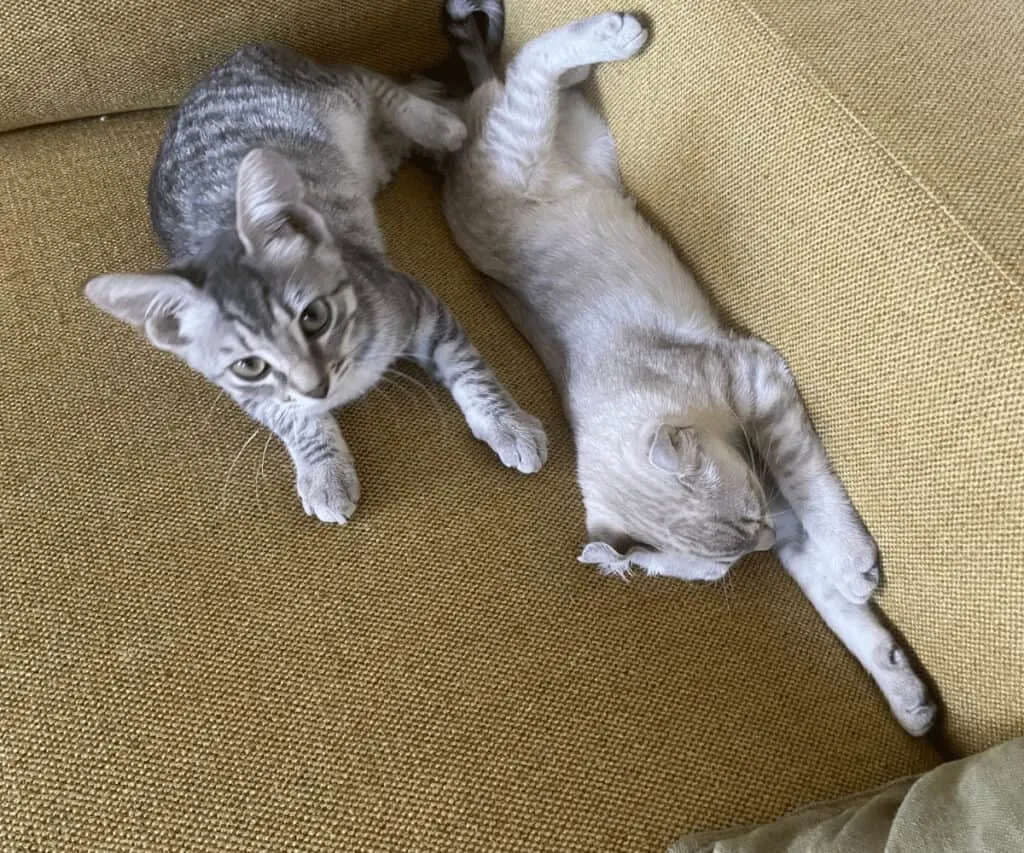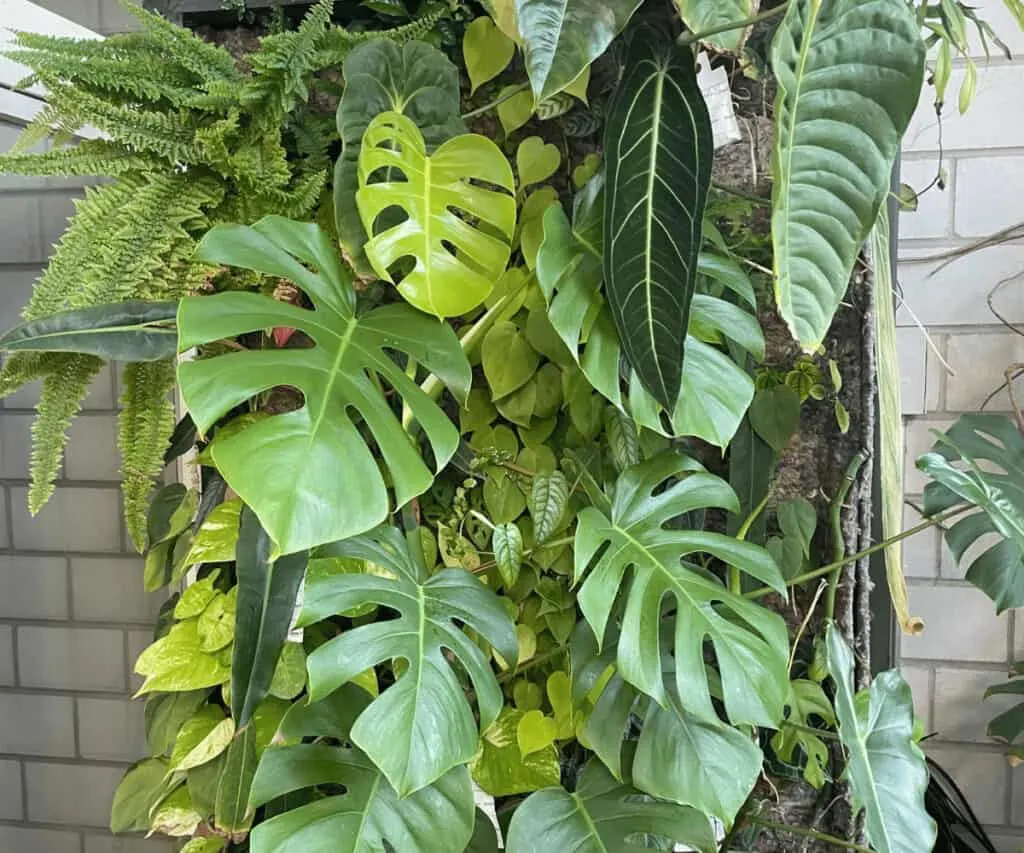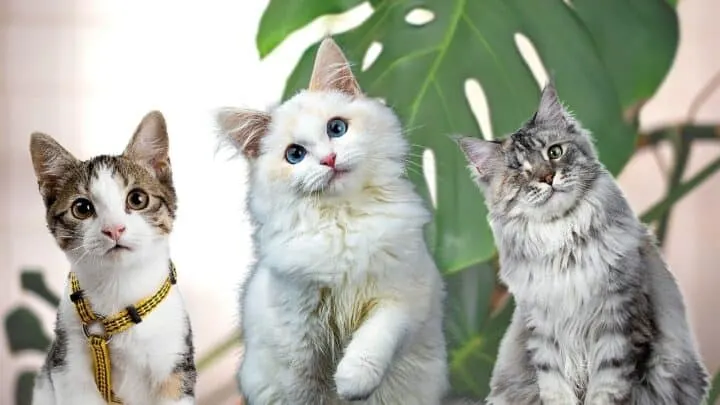Is Monstera deliciosa toxic to cats? Monstera deliciosa is a highly popular houseplant with beautiful foliage and leafy holes. It belongs to the family of Araceae and is also one of the few aroid plants that grow edible fruits. It so happens that many plant parents are also proud owners of pets.
Now, if you own both houseplants & cats, one question is always of particular concern when buying another plant: Is Monstera deliciosa cat-safe or not?
Table of Contents
Is Monstera deliciosa Toxic to Cats?
Monstera Deliciosa is toxic to cats. It contains toxins like insoluble calcium oxalates and is not easily digested in the stomach. This irritates cats’ mouths and tongues as they tend to chew or take a nip of the leaves. Not being able to digest the leaves leads to drooling and sometimes causes the cats to vomit and expel the leaves from their body. It might also cause swelling on their faces and a burning sensation on their tongues, making it difficult to eat food.

Monstera and Cats
Monstera deliciosa is not cat safe. Calcium oxalate is mainly found as crystals in plants’ vascular tubes and tissues.
It is responsible for regulating the calcium levels in the plant and is a defense mechanism against herbivores.
Monstera deliciosa is a plant that produces calcium oxalate and stores it mainly in the leaves.
Some cats have a habit of chewing and nipping on the leaves. If they do this with Monstera Deliciosa, the calcium oxalate is absorbed into the mouth, which triggers acute pain and burning.
This leads to swelling in the mouth and esophagus.
The swelling will cause difficulty in breathing, and there will be other symptoms like drooling and anorexia (loss of appetite).
The cat would start pawing at the mouth and scratch at the irritation.
Your cat will also vomit anything it tries to eat.

How Can Cats Damage Houseplants?
Cats are playful animals, and so they enjoy playing with things such as balls, decorations, and, unfortunately, plants.
While some houseplants are cat-friendly, others, including the Monstera Deliciosa, are highly toxic and should be kept far away from these feline friends.
Often cats chew or scratch their paws against houseplants; this leads to considerable damage, such as wrecked foliage, torn leaves, and ripped flowers. Some cats may even use the houseplants as litter boxes.
In such unpropitious events, instead of giving up on growing your beautiful houseplants, you can do several things to keep your cat away from the plants.
Do Cats Eat a Monstera?
Cats do eat parts of Monstera plants, based on my experience. I have two small cats and several Monsteras. I could spot the cats nibbling on the leaves of the plants. Especially the fenestrated floppy leaves are beautiful. They see the leaves primarily as prey or a playful toy.
They taste the leaves and take them into their mouths. Therefore, keeping the Swiss cheese plant far away from cats is crucial.
How to Prevent Your Cat From Eating a Monstera deliciosa?
Keeping your cat away from the Monstera deliciosa and the plant safe is essential. There are a few steps to help you in protecting both of them. Here is how you can make a Monstera cat safe:
1. Spraying Water
This is one technique to train your cat by spraying water on them. It is an effective method to keep them away from touching the plants.
This helps develop boundaries between the cat and Monstera Deliciosa, where it gets clear to the cat about not touching or trying to nip off the leaves. Of course, this only applies whenever you are home or the cat is in front of you.
This sometimes alerts the cat and prevents it from going near the Monstera Deliciosa.
2. Repellent Spray
Repellent sprays prevent a cat from even getting near the plant.
The cats avoid strong and pungent smells, but it’s essential to be cautious of the ingredients used in the spray.
Make a mixture of water and citrus fruit like lemon or orange for an intense spray. A garlic puree can also be used, but it won’t be strong enough.
If you want a powerful smell, I recommend using a hot chili pepper spray but remain cautious as the spray can irritate the cat’s eyes and nose. Vinegar can also be used, but it may affect the leaves of Monstera Deliciosa.
Spraying on the soil would also help, especially with orange spray. Cover the soil with a piece of landscape fabric and spray it.
It will help if you use the repellent sprays weekly to keep the cat away.
3. Stone Mulch
Cats like loose potting soil mixture because they can use it for the toilet. It’s their favorite spot, and they see it as a litter box.
Try to add a layer of pebbles, which would help to prevent the cat from digging. You can also use seashells, broken ceramics, and smooth glass. This would discourage the cats from disturbing the soil.
Lemon and orange peels are also helpful. Cut slices of both of them. Place them on the soil and make sure to change them weekly.
Ensure you do not pack the soil tightly, as water can’t reach the roots.
4. Placing Monstera Deliciosa in Hanging Baskets
Cats can reach your deliciosa plant with support even if placed at higher positions.
Place the plant in hanging baskets and keep them away from furniture or windows. It would prevent the cat from jumping or going near the plant.
Containers can also be attached to the wall without any support from the shelf to protect Monstera Deliciosa from being attacked by the cat.

5. Creating an Unpleasant Environment
This technique creates an atmosphere where the cats are uncomfortable or stay away.
Place tin foils around your plant. If the Monstera Deliciosa is placed on the table or shelf, place the tin foils loosely around them.
You can also get creative and use sticky tapes around the Monstera Deliciosa to prevent the cat from walking near it. The tacky surface would do the trick.
6. Clean the Litter Box
This might be the main reason cats are attracted to Monstera Deliciosa or any other plant in the house. The cats use the pot as their litter box.
Make sure the litter box is clean and accessible to the cat.
Once in a while, change the litter box if the cat is avoiding it. Cats are picky with the same product being used all the time.
7. Plant for the Cat
Give your cat a plant to chew on. To distract the cat from Monstera Deliciosa, use the help of another pet-friendly plant.
You can use a cat-nip, mint, or even cat grass (a mixture of oat, barley, and thyme). Cats would like to chew on them, and they are entirely safe for them.
8. Caging and Netting
Birdcages are very useful to keep the cat away from Monstera Deliciosa. It can keep Monstera Deliciosa safe from being nipped or eaten.
There are also plant cages and terrarium cages for keeping Monstera Deliciosa safe. There are other barriers like chicken wire and netting.
Chicken wire can be used to adjust and cover the pot’s base. Netting or the drawstring can also be used to cover the outer edges of the pot.
Make sure to put the drawstring tightly around the base of your pot. Cut in the middle of the drawstring for the plant to grow and avoid covering the drainage holes
Frequently Asked Questions
What would happen if my cat digests Monstera Deliciosa?
If the cat digests Monstera Deliciosa, it will suffer from severe pain and vomiting. The cat’s mouth and esophagus would be swelled, and it would have difficulty digesting and eating.
What to do if my cat has eaten Monstera Deliciosa?
The first step is to get the cat to the vet immediately. There is no need to worry if the symptoms and signs are absent. It’s better to be cautious about placing the Monstera Deliciosa away from the cat.
Why are cats attracted to Monstera Deliciosa?
Cats are curious animals, and they love to play around with plants. The glossy and long foliage of the Deliciosa plant often tempts the cat.
Can I have a monstera and a cat?
You can have a Monstera and a cat. To make it work, you need to ensure that the cats cannot get in contact with the plant. You can either put it on a high ground, place it in an enclosed space or use things like odor to keep the cats away.
Takeaways
- Monstera deliciosa is toxic to cats
- It contains calcium oxalate crystals
- Ingestion leads to vomiting and drooling

Daniel has been a plant enthusiast for over 20 years. He owns hundreds of houseplants and prepares for the chili growing seasons yearly with great anticipation. His favorite plants are plant species in the Araceae family, such as Monstera, Philodendron, and Anthurium. He also loves gardening and is growing hot peppers, tomatoes, and many more vegetables.


